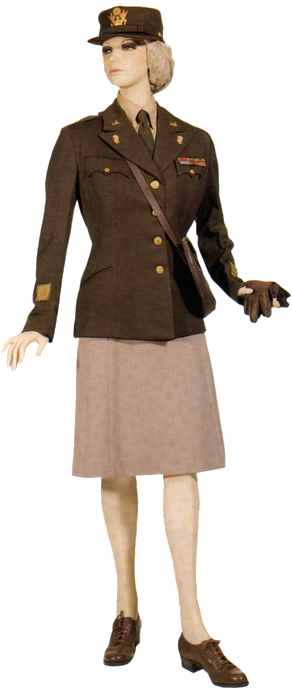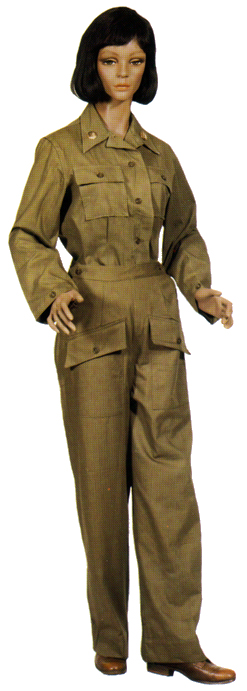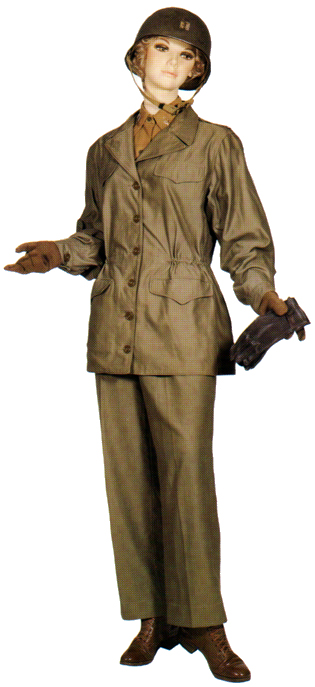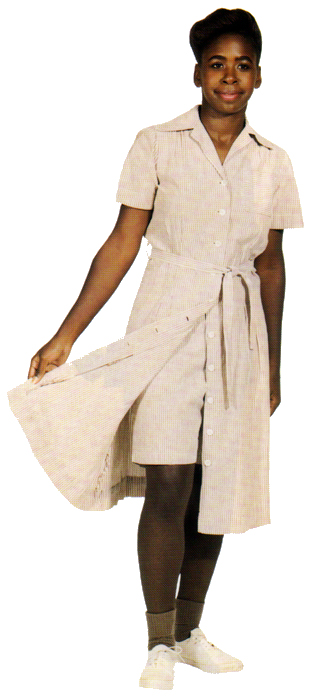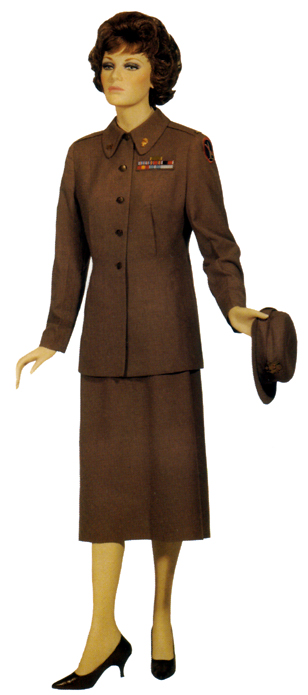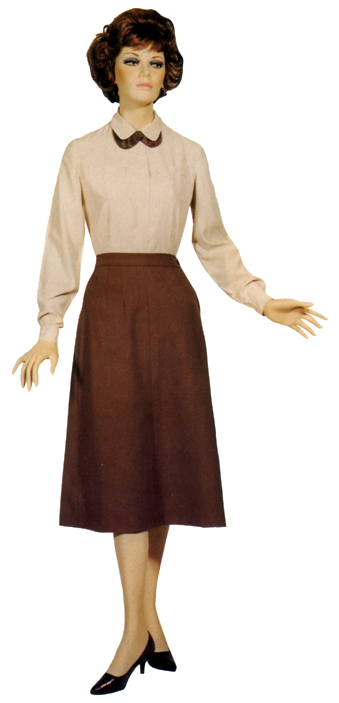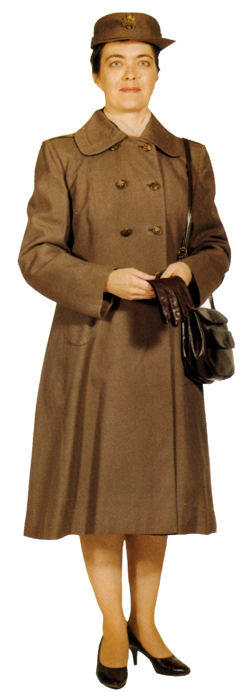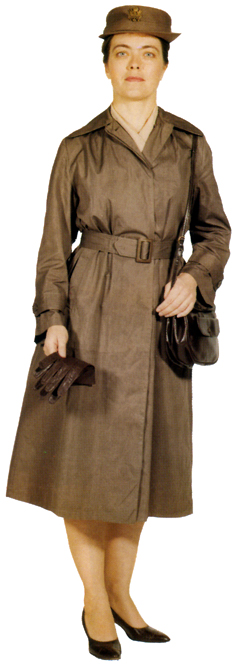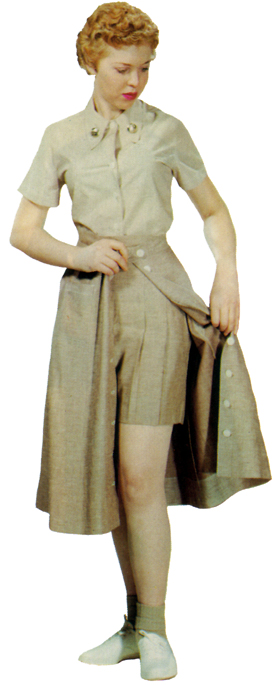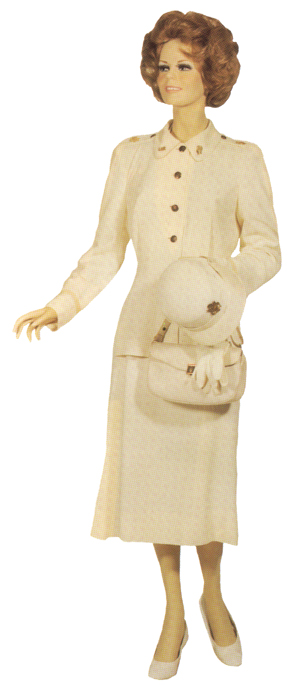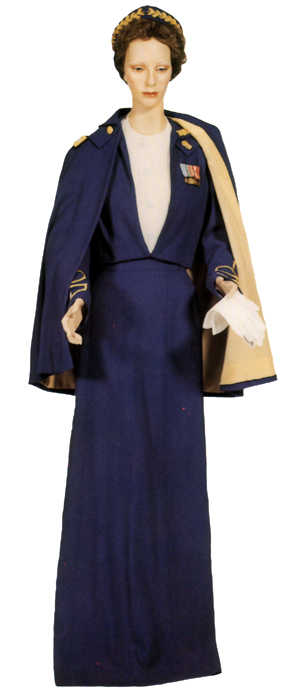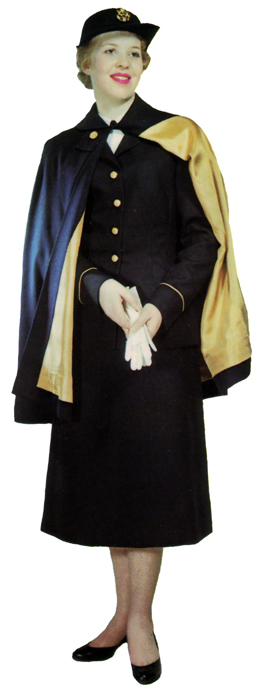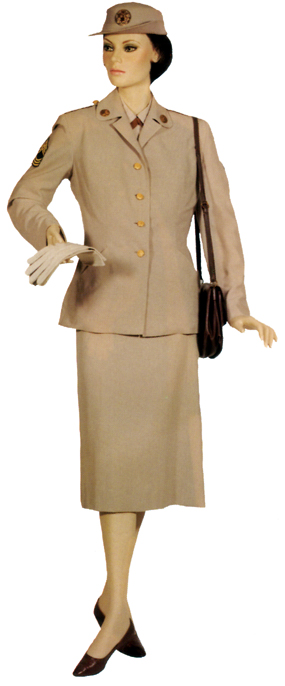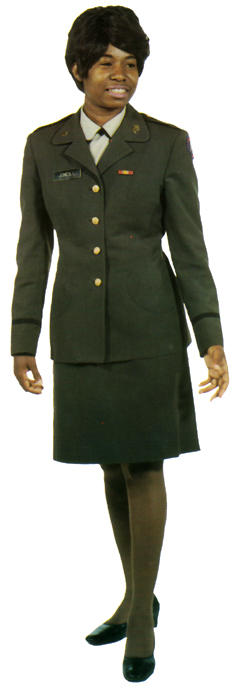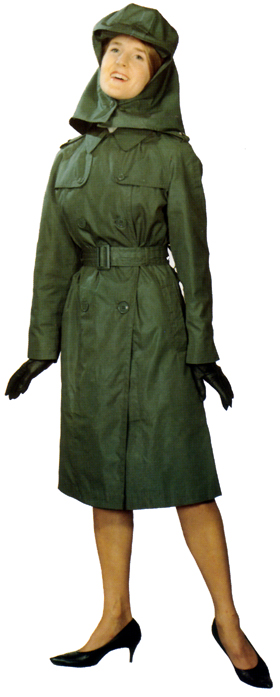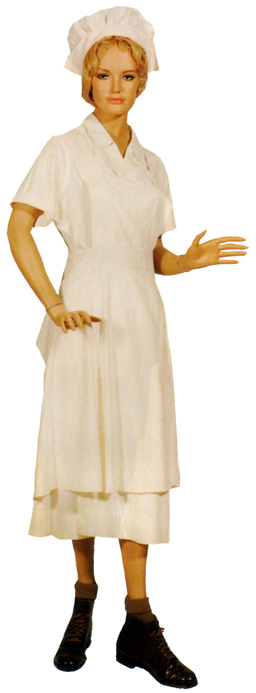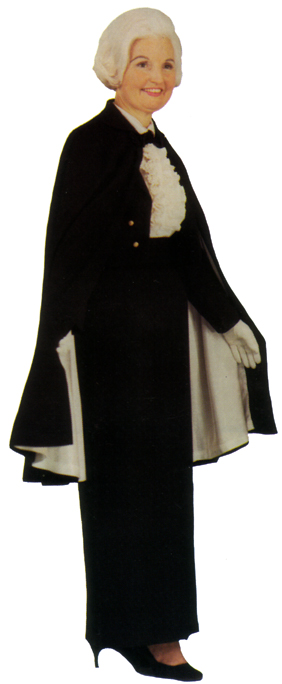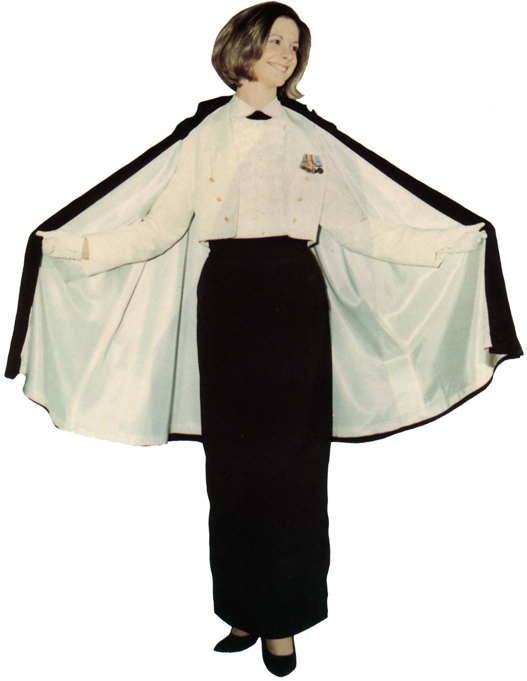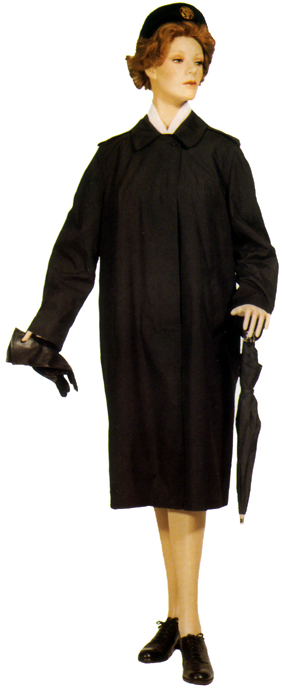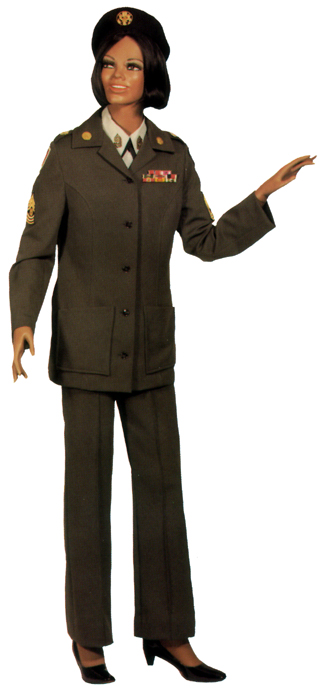- APPENDIX -- D
-
- WOMEN'S ARMY CORPS UNIFORMS
1942-1978
-
- Olive Drab and Khaki Uniforms,
1942-1951
-
- When the Women's Army Auxiliary Corps
(WAAC) was established in May 1942, the Army accepted Director Oveta Culp
Hobby's recommendation that women's uniforms be of the same materials and
colors as the men's. This kept uniform costs low and helped women blend into
the Army scene at posts and camps throughout the United States and overseas.1
While the Corps remained an auxiliary, the Army issued uniforms to WAAC officers
and enlisted women free of charge. However, after 1 September 1943 when the
Women's Army Corps (WAC) became an integral part of the Army of the United
States, WAC officers and warrant officers had to buy their own military clothing,
initially using a one-time uniform allowance given them by the Army. Enlisted
women continued to receive their uniforms free as did enlisted men.2
Neither male soldiers nor WACs (after 1 September 1943) could wear civilian
clothes off duty until September 1946.3
By the end of 1944, the Army Nurse Corps had adopted the WAC service uniform,
raincoat, overcoat, and accessories. The ANC cap, handbag, insignia, off-duty
dress, and hospital duty uniform remained distinctive items of wear for the
nurses.4
-
- In this discussion of uniforms, warrant
officers are included in the term officers unless specifically excluded. But,
whether WAAC or WAC, commissioned, warrant officers, or enlisted, the women
wore the style uniform approved for their era. Officers' uniforms in general
had several distinctive features that set them apart from the uniforms worn
by enlisted personnel. For example, officers' uniforms had shoulder loops
or tabs on outer-wear items such as coats, jackets, and shirts so that rank
insignia could be attached. Officers' uniforms also had a quarter-inch wide
strip of black braid sewn four inches above the cuff of their winter uniform
jackets and overcoats; khaki braid was sewn on their summer uniforms.5
- [437]
- And because officers purchased their
own uniforms, they usually had a choice of fabrics in which they could have
their uniforms made. On garrison caps, officers (male and female) wore an
edging braid of gold and black; enlisted personnel wore a braid with their
branch colors, which, for the WAC, were moss green and old gold.6
-
- The World War II WAC winter service
uniform consisted of a wool, olive-drab skirt, jacket, and cap with visor,
commonly called "the Hobby Hat" (Plate 1). A belt originally
issued with the uniform (summer and winter) was eliminated in late 1942 because
it wore out the material beneath it. The summer service uniform was identical
in style to the winter uniform but was made of 8.2-ounce cotton material in
the khaki shade (Plate 2).7
-
- Few changes occurred in the WAC service
uniform until 1944. Then, in August, the women received a garrison cap, commonly
called an "overseas cap," as a replacement for the Hobby hat that
was difficult to clean, block, and store. The olive-drab plastic buttons imprinted
with the distinctive WAAC eagle-sometimes called the "WAAC buzzard"
because of its lopsided appearance-were replaced by gold-colored metal buttons
with the United States coat of arms imprinted on them. The hat insignia also
changed from the WAAC buzzard to the U.S. coat of arms. And, because the heavy
cotton material of the summer uniform wrinkled easily, buckled, and rode up,
a tropical worsted fabric was substituted that was dry cleanable, wrinkle
resistant, and light in weight for summer wear (Plate 3).8
For off-duty wear, WACs received a uniform dress-one for winter that was a
horizon tan (grayish-pink) color in a wool crepe fabric (Plate 4),
and one for summer that was a pale cream beige in a rayon-shantung fabric
(Plate 5).9
Issue of the off-duty dresses was discontinued in June 1949, but their wear
was authorized until June 1954 when all World War II women's uniform items
were declared obsolete.10
Also in 1944, WACs stationed in Europe received a waist length, olive-drab
wool jacket, called a "battle jacket," that could be worn with matching
skirt or slacks that were already in the supply system (Plate 6).11
In April 1945, the battle jacket was authorized for optional purchase and
wear by officers and enlisted women in the continental United States (CONUS).12
-
- WAC officers usually purchased their
summer service uniform in the tropical worsted material. For winter, they
usually chose the popular "pinks and greens" combination that included
a service jacket in a dark olive-drab (forest green) shade in a wool barathea
or elastique fabric and
- [438]
- a skirt in a light olive-drab shade
(pinkish gray) in a wool twill fabric (Plate 7).13
-
- The only dress uniform for formal
wear that was authorized WAC officers during World War II and the postwar
period was the white uniform. It was made in the same style as the service
uniform and was worn with white accessories (cap, purse, shoes, gloves) and
a black four-in-hand tie (Plate 8).14
The white uniform could be worn off duty or on duty for formal or ceremonial
occasions during the summer months or year around in tropical climates. It
was an optional purchase uniform this meant that the individual authorized
to wear a certain uniform could chose whether to buy it. The white uniform
was not authorized for wear by enlisted women until 1951 (optional purchase).15
-
- Accessories for the WAC service uniform
for officers and enlisted women included a long-sleeved cotton khaki shirt,
cotton khaki tie, russet oxfords with a one-and-a-half-inch heel, and a russet,
mail-pouch style, leather handbag with a shoulder strap. For outer wear the
WACs had a wool, olive-drab overcoat (Plate 9), an olive-drab raincoat
with attached hood, and an olive green utility (all-weather) coat with button-on
parka (Plate 10). Their wardrobe also included ankle-high field shoes,
called "Little Abners" by the women; tennis shoes; galoshes; seasonal
brown leather and tan cotton gloves; an olive-drab, light wool scarf; a tan
cardigan sweater; summer and winter khaki-colored nylon-tricot underwear (bra,
panties, girdle, slip); cotton and flannel pajamas; cotton and rayon stockings
in a suntan shade; and cotton lisle anklets in the khaki shade.16
-
- On duty, WAC officers usually wore
the prescribed service uniform. Enlisted women whose duties were administrative
or light repair and maintenance wore the season's service uniform (skirt,
shirt, tie, garrison cap) with or without the sweater or service jacket. Those
enlisted women assigned to medical or dental duties initially wore a blue
cotton crepe dress, formerly worn by Army nurses. In 1945, however, it was
replaced by a short-sleeved, rose-beige cotton dress (Plate 11).17
The work uniform for enlisted women assigned as mechanics or as chauffeurs,
bus, or truck drivers was a one-piece coverall made of cotton jean cloth in
the khaki shade (Plate 12).18
Early in 1943, the coverall was replaced by dark herringbone twill (HBT) trousers
and shirt for year-round wear (Plate 13).19
HBTs were also worn for field training and as an outdoor work
- [439]
- uniform. In 1944 cotton khaki slacks,
shirts, and caps became the standard issue for women assigned for duty in
the Southwest Pacific Area and other warm weather climates (Plate 14).20
The special duty uniform for women assigned to outdoor work or duty in cold
weather climates included olive-drab wool serge slacks with wool shirts, a
field jacket with a wool liner, wool gloves with leather outer gloves, and
an olive-drab garrison cap. In hazardous areas, on field exercises, or during
alerts, a helmet liner and helmet were issued to the women (Plate 15).21
-
- For physical training, sports, and
fatigue duties (kitchen police, etc.), enlisted women received a green and
white seersucker (later brown and white) dress with matching bloomers or shorts
called an exercise suit (Plate 16). With it, the women wore tennis
shoes or field shoes with cotton or wool anklets, depending upon the season
or occasion, along with a fatigue hat that had a wide brim and a crown that
came to a peak.22
-
- During the postwar era (1945-1950),
women's uniforms changed little. In March 1946, women could buy and wear brown
leather pumps of plain design (i.e., closed toe and heel, no decorative features)
on duty.23
The wearing of pumps off duty had been authorized in March 1944 (optional
purchase) to wear with the off-duty dresses.24
In 1946, nylon hose were issued for the first time to Army women.25
It was the fashion of the day that women's hose, except cotton, had a seam
down the back of the leg, and military women had to be diligent in ensuring
that this seam was always straight. The last uniform change in the postwar
era was the substitution of a dark olive-drab tie in 1949 that replaced the
cotton khaki necktie. The change applied to both men's and women's uniforms.
The dark tie provided a good contrast against the khaki shirt and improved
the overall appearance of the Army uniform.26
-

- Plate 1. Enlisted woman in the winter service uniform (1942-1951), a dark
olive-drab wool material with matching service cap (the "Hobby Hat").
Officers wore the same uniform
- Plate 2 WAC officer in the summer service uniform (1942-1951), a heavy cotton
khaki cloth with matching service cap. Enlisted women wore the same uniform.
- Plate 3. Enlisted woman in a summer uniform and a cap made of a lighter
weight material (1944-1951)-a tan tropical worsted cloth. Officers also wore
the uniform.
- Plate 4. WAC officer in the winter off-duty dress (1944-1951), a grayish-pink
wool fabric. Enlisted women also wore this dress.
- Plate 5. Enlisted women in the summer off-duty dress (1944-1951), a creamy
pearl-white rayon shantung material. Officers also wore this dress.
- Plate 6. Enlisted woman in the winter service uniform with the field jacket
called the "battle jacket" or "Ike jacket" (1945-1951),
an olive-drab wool material. Officers also wore this uniform.
Plate 7. Officer in the semi-dress uniform called the "pinks and greens"
uniform (1942-1954), a dark olive-drab elastique wool material for the jacket
and a light drab wool skirt. Enlisted women did not wear this uniform.
- Plate 8. Officer in the white dress uniform (1942-1951), a tropical worsted
material. Enlisted women were authorized to wear the white dress uniform in
1951.
-
-
- Plate 9. WAC officer's overcoat (1942-1951), an olive-drab wool doeskin
cloth. Enlisted women wore the same style coat in a wool serge cloth without
the shoulder tabs.
- Plate 10. Enlisted woman in the all-weather utility coat (1942-1951), an
olive-drab tackle twill material with a liner and a button-on hood. The officer's
utility coat had shoulder tabs for insignia of rank.
-
-
- Plate 11. Enlisted woman in the hospital duty dress (1945-1962), a rose-beige
(later tan) lawn cotton material, worn with matching garrison cap. This uniform
was not worn by officers.
- Plate 12. Enlisted woman in the one-piece work suit or coverall (1942-1943),
a khaki cotton material. This uniform was worn by officers only during unusual
circumstances.
- Plate 13. Enlisted woman in the two-piece work uniform (1943-1969), a dark
herringbone twill (HBT) material. Worn primarily by enlisted women, it was
worn by officers when required.
- Plate 14. Enlisted woman in the hot weather field uniform (1943-1954), a
khaki cotton poplin material. This uniform was also worn by officers under
some circumstances.
- Plate 15. WAC officer in the winter field uniform (1944-1954), consisting
of olive-drab slacks, wool shirt (worn open or closed) and field jacket worn
with a wool serge garrison cap. Helmet liners and helmets were worn on field
exercises, during alerts, or while working in hazardous areas. Enlisted women
also worn this uniform.
- Plate 16. Enlisted woman in the year-round, seersucker exercise suit for
training classes, for sports, and for fatigue duties (KP, etc). Officers also
wore this uniform.
- The Taupe Uniform, 1951-1959
-
- After Congress authorized women in
the Regular Army and the Army Reserve in 1948, the secretary of the Army approved
the development of a wholly new uniform for women. The director of the WAC,
the chief of the Army Nurse Corps, and the chief of the Women's Medical Specialist
Corps advised representatives of the women's fashion industry on fabric and
style requirements. The experts then proceeded to design fashionable new uniforms
for women. Entries were submitted, and in 1950 the directors and chiefs of
the women's branches and the secretary of the Army approved an ensemble of
uniforms designed by Hattie Carnegie, one of the foremost women's fashion
designers.27
-
- Breaking away completely from the
concept of having women's uniforms resemble men's as much as possible, the
new service uniform featured a brown taupe color, distinctly feminine lines,
and a light-weight wool fabric for year-round wear. The jacket had a round
collar, closed lapels, five buttons from neck to waist, a nipped-in waistline,
slightly padded hipline and shoulders, and two sets of decorative pockets
(Plate 17). The service hat had a molded crown and an up-curving half-brim
rising on the left side. To balance the roll of the brim, the hat insignia
was worn off center on the right hand side. The special duty uniform, worn
for work that required slacks, included a wool taupe battle jacket and wool
taupe slacks, taupe garrison cap, field shoes or cafe brown oxfords. The service
uniform ensemble also included two shirts-a rayon broadcloth and a cotton
chambray-both long sleeved. The shirts, sometimes called shirtwaists or waists,
were worn completely buttoned to the top; later a necktab was added (Plate
18). When a woman left her immediate office or work space, she was required
to wear the wool taupe jacket.28
-
- For summer wear the women received
an open-collar, short-sleeved, cotton taupe dress with a matching garrison
cap and tan cotton gloves (Plate 19). The dress had pockets in the
skirt, antiqued bronze buttons, and shoulder loops. For best appearance, both
dress and cap were lightly starched.29
-
- Cafe brown accessories-handbag, oxfords,
leather gloves-replaced those of russet brown. Taupe shade hose replaced the
brown shade nylons issued to enlisted women after World War II. Outer garments
included a wool serge taupe overcoat with button-in liner that could be worn
in both the raincoat and overcoat (Plate 20), a nylon-rayon taupe
- [457]
- raincoat with removable hood (Plate
21), and tan rayon crepe scarf with fringed ends. Dull antiqued bronze
buttons and hat insignia replaced the shiny brass ones. In the summer the
women wore tan cotton gloves; in winter, cafe brown leather gloves. A taupe
cardigan sweater replaced the khaki-colored sweater.30
-
- In 1949 a monetary clothing allowance
system had been introduced to provide enlisted personnel with a maintenance
allowance to replace worn-out clothing. In 1951 women began to receive an
additional $30 to purchase lingerie and $12 to purchase a pair of pumps or
dress oxfords.31
After this, women no longer received lingerie as items of issue. However,
they continued to receive six pairs of nylon stockings until 1964, when they
received $3 to purchase them instead .32
-
- The uniform for enlisted women who
worked in hospitals and clinics changed in 1951 from the rose-beige cotton
dress to a light tan, lawn cotton dress of the same style. In 1958, a light
taupe, three-piece exercise suit (cotton chambray shirt, denim skirt, and
shorts) replaced the two-piece brown and white seersucker dress and shorts
worn for fatigue duties, physical training classes, and sports (Plate 22).33
-
- The women's white uniform was restyled
in the same design as the taupe service uniform and was worn with white accessories
but without a tie or collar tab (Plate 23). In September 1952, an evening
dress uniform was authorized for wear by commissioned and warrant officers.
This optional purchase ensemble could be worn to formal social functions.
It consisted of a blue wool princess-style jacket, floor-length wool skirt,
white silk blouse, blue tiara with gold thread embroidery, blue suede pumps,
white kid gloves, and a finger-tip length blue wool cape with a gold rayon
lining (Plate 24).34
Few officers other than the director of the WAC and the chiefs of the Army's
other women's branches purchased this uniform because it was so expensive.
In June 1957, a more affordable dress uniform, the Army blue uniform, was
authorized as an optional purchase uniform for officers and enlisted women.
Called "dress blues," this blue wool uniform included a white shirt
with black collar tab. It could be worn in place of the service uniform at
official and unofficial events when prescribed. It could be worn with or without
a dark blue, forger-tip length cape with a gold satin lining (Plate 25).35
The women's dress blue uniform included a shoulder strap on which officers
wore their
- [458]
- insignia of rank, but in October 1959
the Army Uniform Board authorized women officers to wear shoulder boards with
their insignia of rank as male officers did.36
-
- The taupe uniform proved unpopular
from the moment it was issued in 1951. Officers disliked giving up their beloved
"pinks and greens" for the dull taupe shade. Enlisted women complained
about working in a fitted jacket and shirtwaist both of which had to be worn
buttoned to the neck most of the time. The light-weight wool cloth shrank,
lost its shape, and, after several dry cleanings, wrinkled easily. It was
too warm to wear in the summer. The one-sided brim made the hat difficult
to wear correctly. And, despite the claims of the fabric manufacturer, the
taupe raincoat was not water repellent. Adding to those complaints, many women
missed the highly polished brass insignia and buttons, and many thought that
the taupe shade was unbecoming to their complexions.37
In 1953, to alleviate some of the problems, women were authorized to purchase
the taupe uniform in cooler and more wrinkle-resistant fabrics (tropical worsted,
etc.).38
In another concession, during the summer of 1954 only, officers and enlisted
women could wear the white uniform (optional purchase) on duty with the cafe
brown shoes, bag, gloves, and white hat.39
The most welcome relief from the taupe uniform came in 1954 in the form of
a newly designed summer uniform as an optional purchase item for officers
and enlisted women. The new uniform was called the Army beige uniform and
could be worn on and off duty. Worn with a tan shirt and cafe brown collar
tab, it consisted of a light taupe jacket with an open-lapel collar, matching
skirt, and a garrison cap as well as a service hat (Plate 26).40
It was offered in a choice of tropical worsted, gabardine, or a rayon twill
weave; most women preferred the tropical worsted material. Accessories included
the cafe brown handbag, oxfords or pumps, tan cotton gloves, and tan rayon
scarf. This uniform became very popular and was dubbed the "Silver Taupe"
by the women. In 1962, the Army green hat and black accessories began to be
worn with it, and, in that same year, it became a mandatory item for purchase
and wear by WAC officers.41
A tan vinyl raincoat was authorized for purchase by all Army women in May
1960, but it could not be worn in formations.42
-
- Despite the modifications, complaints
about the taupe uniform increased yearly. In 1954 when the Army announced
that men would have a new Army green uniform to be worn with black accessories,
the chiefs
- [459]
- of the women's services had grasped
the opportunity to ask for a matching women's green uniform. In March 1956,
the Army Uniform Board had approved the concept, and within a year the design
for a women's green winter service uniform and a two-piece green cord uniform
for summer had been approved.43
- [460]
- Plate 17. Officer in the year-round,
wool taupe service uniform (1951-1960), worn with tan shirtwaist, cafe brown
oxfords or pumps, and matching service hat. This uniform was also worn by
enlisted women.
- Plate 18. Enlisted woman in the cotton
shirtwaist (1951-1960), worn with the wool taupe service uniform and the work
uniform (HBTs).
- Plate 19. Enlisted woman in the summer
cotton dress (1951-1959), worn with matching garrison cap, cafe brown pumps
or oxfords, tan cotton gloves, and cafe brown handbag with strap worn over
the left shoulder. Officers also wore this dress.
- Plate 20. Officer in the double-breasted
wool serge taupe overcoat (1951-1968), with button-in lining that could also
be worn in the taupe raincoat. The coat was worn with the wool taupe hat or
garrison cap, cafe brown leather purse, cafe brown pumps or oxfords, and gloves.
Enlisted woman also wore this overcoat.
- Plate 21. Officer in the taupe raincoat
(1951-1966), a nylon-rayon cloth. This raincoat, also worn by enlisted women,
had a removable hood and was worn with the button-in liner from the overcoat.
If a scarf were worn, the coat could be unbuttoned to the second button. It
was worn with cafe brown leather purse and gloves or, in summer, the tan cotton
gloves.
- Plate 22. Enlisted woman in the taupe
three-piece exercise suit (1951-1971), consisting of a cotton chambray shirt
and denim cloth skirt and shorts. Later blue, it was worn with white tennis
shoes and cotton taupe anklets for fatigue duties (KP, etc.), physical training,
and sports activities. Officers also wore this uniform.
- Plate 23. Officer in the Hattie Carnegie
style white dress uniform (1951-1960). It was worn with white long-sleeved
rayon, nylon, or silk shirtwaist; no tie or necktab since the jacket was worn
completely buttoned at all times; white leather or white fabric pumps or oxfords;
and white cotton or nylon fabric gloves. Beginning in 1951, enlisted women
could wear this uniform off duty.
- Plate 24. Officer's evening dress
uniform (1952-1969), consisting of a blue wool jacket with gold bullion embroidered
insignia of grade and branch on the sleeves, floor-length wool skirt, cape
with gold rayon lining and gold bullion shoulder straps with embroidered insignia
of grade, and a headband with laurel leaf, gold bullion embroidery. It was
worn with a white silk shirtwaist, white kid gloves, and blue suede pumps.
This uniform was not worn by enlisted women.
- Plate 25. Enlisted woman in the Army
blue uniform (1957-present), a wool barathea material, worn with black accessories.
This uniform was also worn by officers.
- Plate 26. Enlisted woman in the optional
purchase Army beige uniform (19541968), made in a tropical worsted or gabardine
fabric. This summer uniform was worn with cafe brown accessories until 1962,
when black accessories were prescribed. This uniform, sometimes called "the
silver taupe," was also worn by officers.
- The Army Green Uniform, 1959-1978
-
- The first item in the women's green
uniform ensemble was the Army green cord suit, issued in March 1959, in time
for the summer season. It was a two-piece, green and white striped, cotton
polyester suit accented by a dark green cord trim on collars and cuffs and
on the garrison cap (Plate 27). The women's winter Army green service
uniform, issued beginning 1 July 1960, consisted of a wool serge skirt, jacket,
garrison cap and service hat (Plate 28). The uniform was worn with
a long-sleeved tan cotton shirt and a black necktab. The buttons and hat insignia
were an antiqued gold color metal.44
In 1966, in addition to the wool service uniform, enlisted women received
another in a tropical worsted fabric. This addition made the uniform suitable
for year-round wear, and the Army beige uniform was then phased out of the
women's wardrobe. The phase-out was completed on 1 December 1968.45
-
- The changeover from cafe brown to
black accessories (shoes, leather gloves, handbag, necktab) was completed
in August 1962. For summer wear, the tan cotton gloves and scarf were replaced
in 1962 with gray-beige items. A short-sleeved tan shirt was added in 1966
and, beginning in 1972, women could wear a white shirt and black collar tab
with the green service uniform.46
The Navy women's handbag was adopted as a standard item of issue for military
women in 1965, but its small size made it unacceptable to Army women and in
1969 the Army women's handbag was reinstated as a substitute item.47
Beginning in 1960, women wore seamless hose with their uniforms when not in
military formations such as reveille and retreat.48
In 1962, gold color metal buttons and hat insignia replaced the antiqued gold
insignia on both the green service uniform, the green cord, and the beige
uniforms. In 1963, as an optional purchase, women could wear anodized aluminum
buttons on their uniforms.49
The Army green service hat did not enter the supply system until July 1963.
In the interim, and seasonally, women wore the Army green cord or green wool
garrison caps. It was still later, 1966 and 1967 respectively, when they received
the Army green raincoat with button-on havelock (Plate 29) and the
Army green overcoat (Plate 30).50
-
- Though the phase-in period for the
women's Army green wardrobe had been lengthy, by 1 July 1970 all taupe uniform
items were obsolete and women wore the green uniform exclusively.
- [471]
- The work uniform for enlisted women
who held medical or dental MOSs (military occupational specialties) significantly
improved in 1962 when they were issued the white hospital duty dress also
worn by nurses and other women officers in the Medical Department of the Army
(Plate 31). When approved by their hospital commanders, enlisted women
could purchase and wear white oxfords. Some commanders reserved these items
for wear only by women officers as a matter of identity.51
In 1975, when pantsuits became a common item of wear by American women, a
white pantsuit (optional purchase) was added to the women's hospital duty
uniform (Plate 32).52
-
- The work uniform for cooks and bakers
(food handlers) had few revisions between 1942 and 1975. A yellow food-handler's
uniform was tested at WAC Center in 1970, but was never adopted because the
white color was overwhelmingly preferred by the enlisted women.53
The basic duty uniform was a white cotton dress with wrap-around skirt that
could be reversed as the uniform became soiled, an apron, and a chef's cap
(Plate 33). In 1963, a disposable paper cap replaced the chef's cotton
cap.54
In 1975, a white pantsuit with hip length tunic and slacks was added to the
food handler's uniform.55
-
- Between 1943 and 1969, the year-round
women's field duty uniform, usually called fatigues, continued to be the olive-drab
herringbone twill (HBT) shirt, trousers, and garrison cap. After the women's
hot weather field uniform-cotton khaki slacks and shirt-had been declared
obsolete in 1954, HBTs were worn year-round.56
However, after nurses and WACs were assigned to duty in Vietnam in the 1960s,
HBTs proved to be too warm for the climate. In 1969, women serving in Vietnam
received a new hot weather field uniform consisting of a light-weight, olive
green, cotton poplin shirt and slacks and utility (baseball) cap (Plate
34). In 1966, black service boots were issued for wear with the women's
field uniform.57
And, in 1969, the cold weather field uniform changed from the taupe wool jacket
and slacks to an olive green, wool serge jacket, slacks, skirt, and garrison
cap, and a wool flannel or cotton shirt.58
-
- The taupe exercise suit was replaced
in 1969 with a three-piece blue cotton chambray outfit.59
In 1972, the exercise suit was renamed the training duty uniform and a new
two-toned, green uniform was issued. It consisted of cotton poplin shirt,
shorts, and skirt worn with the green cord or Army green garrison cap. Also
that year, women drill sergeants
- [472]
- received a distinctive hat that resembled
the Australian bush hat (Plate 35).60
-
- During the late 1950s and 1960s, the
style and number of women's dress uniforms increased so that they had one
to correspond to each of the men's. The style of the women's white uniform
had changed in 1959 to the open-collar style of the beige uniform (Plate
36)61
And the style of the blue, white, and beige hats changed in 1962 to that of
the new Army green hat. In 1959, the shade of the women's Army evening dress
uniform had changed from dark blue to the midnight blue of the men's evening
dress uniform.62
Then, in 1967, a major innovation occurred when the Army chief of staff approved
a black evening dress and a white evening dress uniform for women. Each was
worn with a black floorlength skirt and either a black or a white mess jacket.
The uniform included a white shirtwaist with black necktab and black cummerbund.
The black evening dress uniform (Plate 37) was worn with black accessories-purse,
gloves, pumps; white accessories accompanied the white evening dress uniform
(Plate 38). At the same time the chief of staff authorized formal mess
uniforms for women-the black mess (Plate 39) and the white mess (Plate
40) and the all-white mess uniform (no plate). Mess jackets and skirts
could be interchanged with accessories to fit the occasion and proper uniform.
The all-white mess uniform consisted of a white jacket, street-length white
skirt, white cummerbund, black necktab, and white accessories. A dark blue
wool, fingertip-length cape or a black wool, street-length cape could be worn
with the black evening dress or black mess uniforms.63
In 1981, enlisted women were authorized to wear the mess uniforms.64
-
- Anticipating a decline in male soldiers
following the end of the draft, the Army initiated a major WAC recruiting
campaign in 1972 that increased by thousands the number of WACs on duty. The
overall expansion campaign for the new all-volunteer Army inspired the director
of the WAC and the other chiefs of the women's branches of the Army to recommend
the redesign of the summer uniform and changes in other items of the women's
wardrobe. In June 1972, the Army chief of staff authorized for optional purchase
and wear with the Army green service uniform, a black beret, black raincoat,
black patent leather pumps, white shirt, white scarf and gloves, and a small
black clutch purse. At the same time, he modified Army tradition by permitting
women in uniform to carry black umbrellas when in uniform, but not while they
were in military formations (Plate 41).65
In 1974, a black raincoat and overcoat
- [473]
- combination with removable liner and
havelock was adopted to replace the green raincoat and green overcoat.66
The black beret became an item of issue in 1975; it replaced the green hat
in 1978 and the green garrison cap in 1980.67
The white shirt, scarf, and gloves became items of issue in 1975, replacing
those tan and gray-beige items.68
-
- By far the most drastic change in
years in women's items occurred in 1974 with the introduction of a (then optional
purchase) redesigned summer uniform-a mint green polyester knit dress with
a long-sleeved jacket. It was worn with the black beret or green hat, black
oxfords or pumps, black handbag, white gloves and scarf. However, the princess
style of the dress was not comfortable for most work situations and it was
not adopted. In its place, the Army tested and in 1975 chose a mint green
polyester knit skirt and jacket uniform (Plate 42).69
Both long- and short-sleeved jackets were issued to give the women a choice.
A shirt was not worn with this uniform. It replaced the green cord uniform
as an item of issue in 1975. The green cord was declared obsolete after 1
October 1981.70
-
- Another major change in women's uniforms
occurred in 1976 with the issue of a green pantsuit.71
Women assigned military police duties were the first to wear the pantsuit
as a duty uniform (September 1976). It consisted of polyester wool gabardine
slacks and jacket, worn with either a gray-green sleeveless turtleneck tunic
or a white shirt with black necktab (Plate 43). A white turtleneck
tunic was tested but not adopted. The green pantsuit became an item of issue
in November 1977.72
- [474]
- Plate 27. Enlisted woman in the Army
green cord uniform (1959-1980), of green and white striped polyester and cotton
cord material. Worn initially with a matching green cord cap, it was later
worn with the Army green hat and the black beret. Officers also wore this
uniform.
- Plate 28. WAC officer in the Army
green service uniform (1960-1981), a wool serge skirt, jacket, garrison cap
and hat. In 1966, in addition to the wool service uniform, enlisted women
were issued a tropical worsted uniform, making this a year-round uniform.
- Plate 29 Officer in the Army green
raincoat (1966-1985), with removable havelock but no liner. Made of a water-repellant
cotton-polyester poplin material, this raincoat could be worn open at the
collar, with or without the gray-beige scarf. It was also worn by enlisted
women.
- Plate 30. WAC officer in the women's
green overcoat of wool gabardine with removable liner (1967-1985). The overcoat
collar could be worn open or closed, with or without the gray-beige scarf.
The overcoat was also worn by enlisted women.
- Plate 31. Enlisted woman in the white
hospital duty dress (1962-1975), Of cotton poplin, this uniform was worn with
black oxfords or optional purchase white oxfords when authorized. The women's
green cardigan sweater could be worn on duty. Women officers in the Army Medical
Department wore this uniform with cap, white stockings, and oxfords. Civil
service employees performing patient care could also wear the white uniform.
''
- Plate 32. Enlisted woman in the hospital
duty uniform pantsuit authorized m 1975 as an optional purchase item-it later
became an item of issue. Women officers in the Army Medical Department also
wore this uniform on duty in medical care facilities.
- Plate 33. Enlisted woman in the traditional
food handler's uniform. This uniform had few modifications between 1944 and
1975, when a pantsuit was authorized for food handlers. Officers did not wear
this uniform.
- Plate 34. Enlisted woman in the hot
weather field uniform (1969-1981), olive-green cotton poplin shirt and slacks
worn with a utility cap. Officers also wore this uniform.
- Plate 35. Drill sergeant in the year-round
training duty uniform (1971-1981), a light green cotton poplin shirt and darker
green cotton shorts and skirt worn with a garrison cap or, as shown here,
with the distinctive hat worn only by women trained to be drill sergeants.
Upon certain occasions (instructing, etc.) women officers also wore the training
duty uniform.
- Plate 36. Officer wearing the Army
white uniform in the open collar style introduced in 1959. The straight-brimmed,
matching fabric hat replaced the turned-down brim style of the taupe hat in
1962. Enlisted women also wore this uniform.
- Plate 37. Officer wearing the Army
black evening dress uniform authorized in 1967. Enlisted women did not wear
this uniform.
- Plate 38. Officer in the Army white
evening dress uniform (authorized 1967) with the optional, street-length,
black wool cape. Enlisted women did not wear this uniform.
- Plate 39. Officer in the Army black
mess uniform (authorized 1967). Enlisted women were authorized to wear all
the mess uniforms in 1981.
- Plate 40. Officer in the Army white
mess uniform, authorized in 1967.
- Plate 41. Enlisted woman in the black
raincoat, black beret, white scarf, and carrying the black umbrella authorized
for women in 1972. Officers also wore these items.
- Plate 42. Enlisted woman in the mint
green summer uniform made of a polyester knit material (1975-1985). A long
or short-sleeved jacket was worn with this uniform.
- Plate 43. Enlisted woman in the
Army green pantsuit issued in 1976 to women who performed military police
duties and in 1977 to all enlisted women. The jacket and slacks were of
a polyester wool gabardine. A white shirt with black necktab or a rib-knit
gray-green turtleneck tunic was worn with this uniform. Officers also wore
this uniform.
Return
to the Table of Contents






